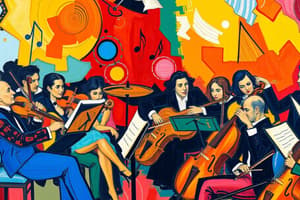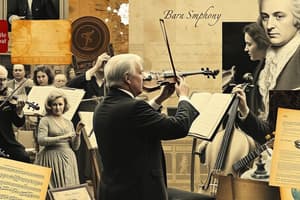Podcast
Questions and Answers
This passage with static harmony leading up to the full return of the theme functions like which section in sonata-allegro form?
This passage with static harmony leading up to the full return of the theme functions like which section in sonata-allegro form?
retransition
As is true of most rondos, which of the following is correct?
As is true of most rondos, which of the following is correct?
- Both A and B (correct)
- Neither A nor B
- The only shift to minor occurs in a contrasting theme.
- The refrain is always in a happy-sounding major key
A natural trumpet plays?
A natural trumpet plays?
descending triads and rising octaves
Judging from this movement and your experience with sonata-allegro form, which statement is true?
Judging from this movement and your experience with sonata-allegro form, which statement is true?
What is a core repertoire, or the 'chestnuts,' of classical music performed at concerts continually since the eighteenth century?
What is a core repertoire, or the 'chestnuts,' of classical music performed at concerts continually since the eighteenth century?
What is the last movement of a multi-movement composition, one that usually works to a climax and a conclusion?
What is the last movement of a multi-movement composition, one that usually works to a climax and a conclusion?
What classical musical form must have at least 3 statements of the refrain A and at least two contrasting sections?
What classical musical form must have at least 3 statements of the refrain A and at least two contrasting sections?
What is a musical form in which a theme continually returns but is altered?
What is a musical form in which a theme continually returns but is altered?
What is the style/era of Concerto for Trumpet and Orchestra?
What is the style/era of Concerto for Trumpet and Orchestra?
What movement is this?
What movement is this?
What is the genre of this piece?
What is the genre of this piece?
What is the form of this piece?
What is the form of this piece?
Who plays the refrain?
Who plays the refrain?
What range is the trumpet?
What range is the trumpet?
In the end, what is the pause intended for?
In the end, what is the pause intended for?
Who is referred to as the father of the symphony and the string quartet?
Who is referred to as the father of the symphony and the string quartet?
What important thing did Haydn develop?
What important thing did Haydn develop?
Who did Haydn work for?
Who did Haydn work for?
Study Notes
Haydn's Trumpet Concerto in E-flat Major
-
Retrospective Function: The retransition in sonata-allegro form creates static harmony preceding the theme's full return.
-
Rondo Characteristics: Rondo typically features a single joyful refrain, primarily in major key, with a minor shift appearing only in contrasting themes.
-
Natural Trumpet: The instrument predominantly produces descending triads and rising octaves.
-
Form Comparisons:
- Rondo emphasizes one theme, typically presented without alteration.
- Theme and variations maintain a single theme with continuous ornamentation.
- Sonata-allegro incorporates multiple themes, often lacking a sole dominant theme.
Core Repertoire
- Canon of Western Music: Refers to essential works consistently performed since the 18th century.
Movement Structure
- Finale: Represents the conclusive and climactic segment of multi-movement works.
Rondo Form
- Definition: A classical structure requiring at least three statements of the refrain (A) along with contrasting sections (B and C).
Theme and Variations
- Definition: A structure where a recurring theme undergoes transformations in melody, harmony, rhythm, or other musical elements.
Contextual Information
-
Style/Era: The "Concerto for Trumpet and Orchestra" is classified within the Classical style.
-
Movement Identification: This piece constitutes the third movement of the composition.
-
Genre Classification: Identified as a concerto, showcasing a solo instrument with orchestral accompaniment.
Musical Structure
-
Form Specification: The specific form of this piece is Rondo, encapsulated as ABABACABA.
-
Refrain Performance: The refrain is initially performed by the strings, later joined by the complete orchestra.
-
Trumpet Range: Classified within the soprano range.
Performance Aspects
- Improvised Solo: The intended pause toward the end of the piece is designated for an improvised solo section.
Haydn’s Contribution
-
Title of Father: Referred to as the father of the symphony and string quartet for his foundational work in these forms.
-
Development Focus: Notably contributed to the finale structure of the symphony.
Work Environment
- Patron: Worked under Prince Esterházy, a significant patron of the arts during his time.
Studying That Suits You
Use AI to generate personalized quizzes and flashcards to suit your learning preferences.
Description
Test your knowledge on Chapter 15 of Haydn's Trumpet Concerto in E flat Major. This quiz features flashcards that cover important concepts such as sonata-allegro form and characteristics of rondos. Perfect for music students and fans alike!




